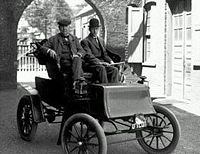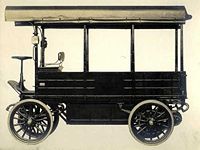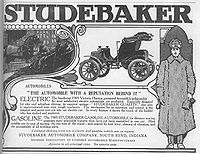
Studebaker Electric (automobile)
Encyclopedia




South Bend, Indiana
The city of South Bend is the county seat of St. Joseph County, Indiana, United States, on the St. Joseph River near its southernmost bend, from which it derives its name. As of the 2010 Census, the city had a total of 101,168 residents; its Metropolitan Statistical Area had a population of 316,663...
, a forerunner of the Studebaker Corporation
Studebaker
Studebaker Corporation was a United States wagon and automobile manufacturer based in South Bend, Indiana. Founded in 1852 and incorporated in 1868 under the name of the Studebaker Brothers Manufacturing Company, the company was originally a producer of wagons for farmers, miners, and the...
. The battery-powered cars were sold from 1902 to 1912.
Studebaker entered into the automobile manufacturing field in 1898 when Frederick S. Fish
Fred Fish (lawyer)
Frederick Samuel Fish , born in Newark, New Jersey, was an American lawyer, politician and automotive manufacturing executive. Originally a successful corporation lawyer, he entered the Studebaker corporation through marriage and became the corporation's president in 1909 and chairman of the board...
, as chairman of the executive committee, persuaded the board to supply $4,000 for the development of an electric vehicle
Electric vehicle
An electric vehicle , also referred to as an electric drive vehicle, uses one or more electric motors or traction motors for propulsion...
. However, lacking the board’s full support, the project yielded one car. The company did, however, enter into the field of producing bodies for electric taxis through Albert Augustus Pope
Albert Augustus Pope
Albert Augustus Pope was a Brevet Lieutenant-Colonel who founded the Pope Manufacturing Company in 1877. -Birth:...
’s Electric Vehicle Company.
Studebaker formally began production in earnest in 1902, and the company chose battery-powered electric vehicles because they were clean, easily recharged, and worked well in urban centers without need of refueling depots (gas station
Filling station
A filling station, also known as a fueling station, garage, gasbar , gas station , petrol bunk , petrol pump , petrol garage, petrol kiosk , petrol station "'servo"' in Australia or service station, is a facility which sells fuel and lubricants...
s).
Studebaker Electrics were available in a variety of body styles, many of which mimicked the bodies that it had long produced for its lucrative passenger carriage line. These included the Stanhope
Stanhope
-Places:* Stanhope, Victoria, Australia* Stanhope, Prince Edward Island, Canada* Stanhope, Quebec, Canada* Stanhope, County Durham, England, UK* Stanhope, Kent, England, UK* Stanhope, Peeblesshire, Scotland, UK* Stanhope, Iowa, US* Stanhope, New Jersey, US...
, Victoria, and Surrey. A four-passenger model was introduced in 1904.
Fish realized early on that Studebaker’s future did not rest in the limited electric car, but in the gasoline-powered automobile. Studebaker’s field of expertise was in body building and product distribution, not engine building. This realization led to the creation of the Studebaker-Garford automobile in 1904. The joint agreement worked well until 1909-1910 when Garford attempted to divert chassis to its own brand of automobile, and Studebaker, looking for an affordable car to sell entered into an agreement with the E-M-F Company of Detroit. E-M-F would build the entire car, which would then be distributed through Studebaker wagon dealers.
Still, Studebaker continued to build electric vehicles until Fish decided to begin the process of seizing control of E-M-F in 1909, which Studebaker completed by 1910.
By 1912, it became conventional wisdom that the future lay in gasoline-powered engines rather than heavy, sluggish electrics, and the limited production of electric cars stopped. An official announcement from the newly re-incorporated Studebaker Corporation stated:
-
- The production of electric automobiles at South Bend has ended. . . It has been conducted for nine years without much success, and ultimately the superiority of the gasoline car (is) apparent.

